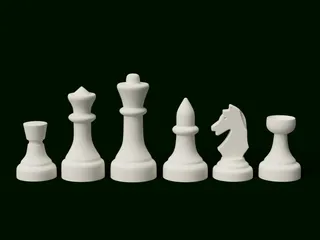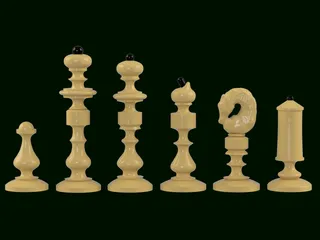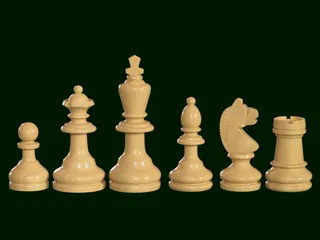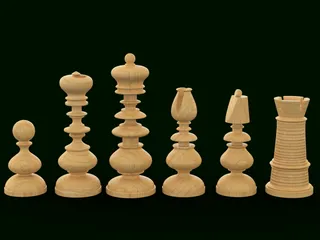Soviet-era Russian Poni Minimalist Chess Set
Description
PDFThe Historical Chess Set Series
#5 - Russian Poni Minimalist Chess Set
Chess sets come in all shapes and sizes, but few are as distinctive as the Soviet-era Russian Poni Minimalist Chess Set. Designed in the 1920s by Alexey Poni, this set is known for its simple, geometric shapes and lack of ornamental details. It has become a classic example of functional design, and its minimalist style has inspired many designers.
One of the defining features of the Poni Minimalist chess set is its size. The King is typically around 3 to 3.5 inches (76 to 89 millimeters) tall, making it relatively small compared to other chess sets. This size matches the set's minimalist aesthetic, which values simplicity and functionality over ornamental details.
Despite its popularity among chess enthusiasts and designers, the Poni Minimalist chess set is rare because it was produced only in limited quantities during the Soviet era. Although the Poni set intended to make chess more accessible to the masses, the Poni chess set never reached mass production in the same way as other sets. Instead, skilled artisans often handmade them, meaning each was unique.
A lack of export outside the Soviet Union added to the rarity of the Poni chess set. This export restriction, due in part to political tensions between the Soviet Union and other countries, kept the set in obscurity. Additionally, countries viewed the set as a symbol of Soviet design and ideology. As a result, it was less well-known in the West than other sets, such as the Staunton set.
Despite its rarity, the Poni Minimalist chess set has a devoted following among chess enthusiasts and collectors. Its distinctive style and historical significance make it a highly sought-after item, with some chess sets fetching high prices at auction. There has been a renewed interest in the Poni set recently, with designers and collectors seeking original sets or creating replicas.
NOTES:
This chess set constitutes one of my biggest challenges when researching its background. This set is so rare I cannot find a photograph of an original chess set anywhere in my typical sources. I know this set existed because I made a series of sketches in a notebook years ago when I first became interested in Russian chess sets. However, I needed to record where I had seen the chess set or where I got the inspiration for the sketches.
Upon an initial search for photographs, to my surprise, dozens of reproductions and replicas are available from all the significant chess set retailers. These reproductions fall into two categories: one with no finial on the pawn and bishop and one with a ball finial on the pawn and bishop. My sketches do not show any finials on the bishop or pawn.
I suspect the addition of the ball finial makes the pieces easier to pick up and move. After playing with a set without the finial, I came to this conclusion when I found the "pointy" smooth surface challenging to grab and hold onto. Therefore, I have included two models for the pawn and bishop, with and without the ball finial.
Size (height/base):
With a king height of 77.2 mm (3.3"), this sets size is that of Staunton Scale 3 (St. 3).
- ♔ King: 77.2 mm / 32 mm
- ♕ Queen: 62.8 mm / 31.7 mm
- ♗ Bishop: 55.5 mm / 28.5 mm
- ♗ Bishop alternate: 57.7 mm / 28.5 mm
- ♘ Knight: 51.7 mm / 28.5 mm
- ♖ Rook: 45.2 mm / 31.1 mm
- ♙ Pawn: 36.8 mm / 27.9 mm
- ♙ Pawn alternate: 40.2 mm / 28.1 mm
Scaling:
Keep in mind that this is a small chess set. A tournament-sized chessboard with 2.25-inch squares will swallow this set. I suggest displaying this set on a chessboard with 40 - 45 mm squares. Alternatively, to play the chess set on a tournament-sized board, scale the pieces before printing them.
To resize this set to one of the following standard sizes, scale the model by the factor given before printing.
- FIDE Size 1 - St. 5 (King 87 mm): 1.13 (113%)
- FIDE / UCSF Tournament - St. 6 (King 94 mm): 1.22 (122%)
- Club Size - St. 9 (King 112 mm): 1.45 (145%)
ABOUT THE HISTORICAL CHESS SET SERIES:
Introducing a remarkable resource for chess lovers and history buffs – a collection of historical chess set printable models from around the world! Immerse yourself in the game's rich cultural history with designs ranging from the ancient world to modern times. Each set is a testament to the artistry and craftsmanship of its era that showcases the evolution of chess throughout the centuries, providing a stunning visual representation of the game's journey that will impress any chess enthusiast. Whether you're a seasoned player or a history buff, this collection has something to offer everyone. Join us on a journey through time and discover the beauty and intricacy of chess through these historical sets, which will captivate, inspire, and invite you to engage with the game in a whole new way.
CHESS SETS IN THIS SERIES:
- Man Ray 1945 Prototype Wood Chess Set - March 13, 2023
1945 Wood Chess Set prototype design by Man Ray, as illustrated in the book "Imagery of Chess, Revisited". - Austrian Biedermeier Coffeehouse Chess Set - March 19, 2023
An Austrian chess set in the Biedermeier Coffeehouse style made around the Biedermeier period between 1815 and 1850. - French Directoire Chess Set - March 26, 2023
A classic French chess set design, also called the French Revolutionary chess set, from the Directoire period 1795-1799. - English Rowbotham Chess Set - March 26, 2023
A stylized chess set commissioned by the Reverend Rowbotham from John Jaques of London and designed by Nathaniel Cook. - Soviet-Era Russian Poni Minimalist Chess Set - March 31, 2023
Russian chess set designed in the 1920s by Alexey Poni, a classic example of minimalistic style and functional design. - French Dierdot Chess Set - April 8, 2023
French chess set also known as the Encyclopédie Chess Set, an artifact of the 18th-century French Enlightenment period. - Leonardo Da Vinci's Chess Set - April 14, 2023
Leonardo Da Vinci's chess set design found in De Ludo Scachorum, written by Luca Pacioli, a Renaissance mathematician. - Duetsche Bundesform Chess Set - April 21, 2023
Deutsche Bundesform (German Federation Form) chess pieces used exclusively at the Munich Chess Olympiad in 1936. - Czechoslovakian Coffeehouse Chess Set - April 28, 2023
A vintage coffeehouse style chess set similar to those made in Czechoslovakia (Czech Republic) ca. 1950. - Romanian Bundesform Chess Set - May 7, 2023
Chess set originating in Romania in the early 20th century exhibiting the German Bundesform style of chess pieces. - Polish Coffeehouse Chess Set - May 15, 2023
A rare Polish coffeehouse design heavily influenced by Austrian aesthetics and the popular Regence style of 18th Century France. - Budapest/Hungarian Chess Set - May 19, 2023
This is a unique and elegant Staunton-inspired chess set made in Hungary ca. 1920's-1930's with a rare Knight shape. - Bulgarian Chess Set - May 26, 2023
A beautiful Bulgarian design chess set inspired by a handmade set made in Bulgaria/Eastern Europe ca. 1950s–1960s. - Soviet-era Latvian Chess Set - June 2, 2023
Chess set similar to the one seen in the final game between Beth and Vasily in the Netflix Series, "The Queen's Gambit". - Old Windsor Castle Chess Set - June 9, 2023
Rare souvenir set of chessmen made using the old oak from the St. George Chapel at Windsor Castle during the 1820s. - German Bohemia Chess Set - June 16, 2023
German Bohemia chess set with "chicken-head" Knight made circa 1970s and designed for the 1970 Siegen Chess Olympiad.
Look for future weekly releases, including rare and beautiful Yugoslavian, and Romanian chess sets. Send me a message if you have a particular chess set design that you would like to see as a 3D model. I am always open to new ideas. Although I have steered clear of the Staunton design, I am considering adding the more popular formats, like the 1959 Zagreb and the 1950 Dubrovnik sets. Let me know if you are interested in adding Staunton sets.
FAIR AND COMMERCIAL USE:
The models in the Historical Chess Set Series allow others to enjoy playing the game of chess with something other than standard Staunton chess pieces (see license below). These models are licensed for an individual's personal use. Individuals may print sets to give away, providing parties have no other value exchange. Any commercial printing or distribution is strictly prohibited. Please don't make me wake up my lawyer; she's grumpy when she doesn't get her beauty sleep, and you will suffer the consequences.
DISCLAIMER:
Please be advised that there is no intention that the models and representations provided herein are exact reproductions of their original counterparts. Instead, they should be regarded as artistic interpretations, reflecting the creativity and vision of the artisan.
The artisan has made every effort to ensure the accuracy and fidelity of these models. It is essential to recognize that they may contain variations, deviations, or artistic liberties the artisan took to enhance their aesthetic appeal or convey a particular message.
As such, we encourage users to appreciate these models for their artistic value and creative expression while acknowledging that they may not be precise replicas of the original subjects. Please enjoy these works with an open mind and a discerning eye, understanding that they represent a unique blend of historical inspiration and artistic interpretation.
Tags
Model origin
The author marked this model as their own original creation.




